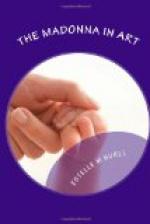CHAPTER VIII.
THE MADONNA AS WITNESS.
In proportion to a mother’s ideals and ambitions for her child does her love take on a higher and purer aspect. The noblest mother is the most unselfish; she regards her child as a sacred charge, only temporarily committed to her keeping. Her care is to nurture and train him for his part in life; this is the object of her constant endeavor. Thus she comes to look upon him as hers and yet not hers. In one sense he is her very own; in another, he belongs to the universal life which he is to serve. There is no conflict between the two ideas; they are the obverse sides of one great truth. Both must be recognized for a complete understanding of life. What is true of all motherhood finds a supreme illustration in the character of the Virgin Mary. She understood from the first that her son had a great mission to fulfil, that his work had somewhat to do with a mighty kingdom. Never for a moment did she lose sight of these things as she “pondered them in her heart.” Her highest joy was to present him to the world for the fulfilment of his calling.
As a subject of art, this phase of the Madonna’s character requires a mode of treatment quite unlike that of the Mater Amabilis or the Madre Pia. The attitude and expression of the Virgin are appropriate to her office as the Christ-bearer. Both mother and child, no longer absorbed in each other, direct their glance towards the people to whom he is given for a witness. (Isaiah 55:4.) These may be the spectators looking at the picture, or the saints and votaries filling the composition. The mother’s lap is the throne for the child, from which, standing or sitting, he gives his royal blessing.
It will be readily understood that so lofty a theme can not be common in art. In our own day, it has, with the Madre Pia, passed almost entirely out of the range of art subjects; modern painters do not try such heights. Franz Defregger is alone in having made an honest and earnest effort, not without success, to express his conception of the theme. To his Enthroned Madonna at Doelsach, and his less well-known Madonna in Glory, let us pay this passing word of honor.
To approach our subject in the most systematic way, we will go back to the beginnings of Madonna art. Mrs. Jameson tells us that the group of Virgin and Son was, in its first intention, a theological symbol, and not a representation. It was a device set up in the orthodox churches as a definite formalization of a creed. The first Madonnas showed none of the aspects of ordinary motherhood in attitude, gesture, or expression. The theological element in the picture was the first consideration. We may take as a representative case the Virgin Nike-peja (of Victory), supposed to be the same which Eudocia, wife of the Emperor Theodosius II., discovered in her travels in Palestine, and sent to Constantinople, whence it was finally brought to St. Mark’s, Venice. The Virgin—a half-length figure—holds the child in front of her, like a doll, as if exhibiting him to the gaze of the worshippers before the altar over which the picture hung. Both faces look directly out at the spectator, with grave and stiff solemnity.




